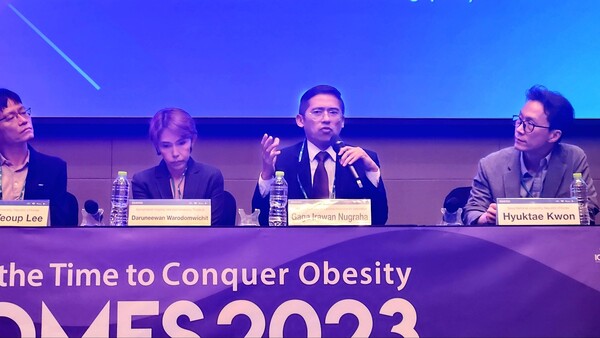Representatives from the Asia-Pacific drew urgency to the need to come to a consensus on the appropriate standards and criteria to evaluate obesity to avoid confusion and lead to improved obesity outcomes in Asia.

The Korean Society for the Study of Obesity (KSSO) hosted the 2023 International Congress on Obesity and Metabolic Syndrome (ICOMES) ending day 1 with a panel discussion highlighting obesity trends, definitions, and standards used in Asian countries on Thursday at the Conrad Hotel.
However, it appears that across the Asia-Pacific, the standards and criteria for classifying obesity differ with varying cut-off points.
For example, in Korea, the standards for measuring obesity are taken from body mass index (BMI) measurements which are recorded from the national health insurance check-up appointments. However, Indonesia’s representative, Dr. Gaga Irawan Nugraha of the Universitas Padjadjaran, shared that their public health system tries to encompass BMI together with chronic disease and laboratory indicators to avoid the onset of these diseases.
Thailand also used a similar BMI system to Korea but focused on the waist circumference measurement.
“In Thailand, the optimal waist circumference is defined as half of the height but patients are defined to be at risk for developing obesity if the waist circumference exceeds this standard,” said Dr. Daruneewan Warodomwichit of Ramathibodi Hospital.
Dr. Lee Sang-yeoup of Pusan National University also pointed out a study that showed that Koreans have significantly lower adiponectin levels than their Western counterparts so the Korean obesity standard should differ from the Western standard.
Taiwan’s representative also said that they use a five-factor score consisting of obesity indicators including BMI, body fat percentage, waist circumference, hip circumference, and waist-hip ratio.
“If the score is over 85 percent, we define that as obesity,” said Lin Wen-yuan of China Medical University and Hospital.

The Singapore representative, Kwang Wei Tham of Woodlands Health noted that the government is trying to address health interventions specific to ethnic populations within Singapore due to its largely diverse population. However, she noted that they are also forced to subscribe to the guidelines set by the FDA and the EMA as pharmaceutical companies first approve drugs in Europe and the U.S. which later become available in their country. In this regard, she noted that clinical trials should encompass a diverse ethnic population so that the drugs can be effectively applied to the Asian population.
Meanwhile, Japan only classifies obesity as a BMI greater than or equal to 25, overlooking the classification for overweight populations.
“Not all of the obese population is unhealthy,” said Japan’s representative Koutario Yokote, the Chairman of the Japan Society for the Study of Obesity (JASSO). “We extract the obese population that needs medical attention but ignore overweight classification as this can lead to excessive medical intervention.”
According to the World Obesity Atlas Report 2023, the proportion of obesity in men in Southeast Asia is expected to rise from 4 percent in 2020 to 10 percent by 2025 and from 8 to 16 percent in women at the current rate. As the obesity prevalence continues to increase in the Asia-Pacific region, panelists called for the integration of obesity standards and cut-off points to better guide clinical practice and patient health interventions.
Related articles
- Risk of early-onset colorectal cancer 20% higher for heavy drinkers: study
- Daewon Pharm applies for trial of patch-type obesity treatment
- Korean researchers identify obesity-causing diabetic mechanisms 'for 1st time'
- Korean leadership in BCI standardization: new proposal OKed for international data format

